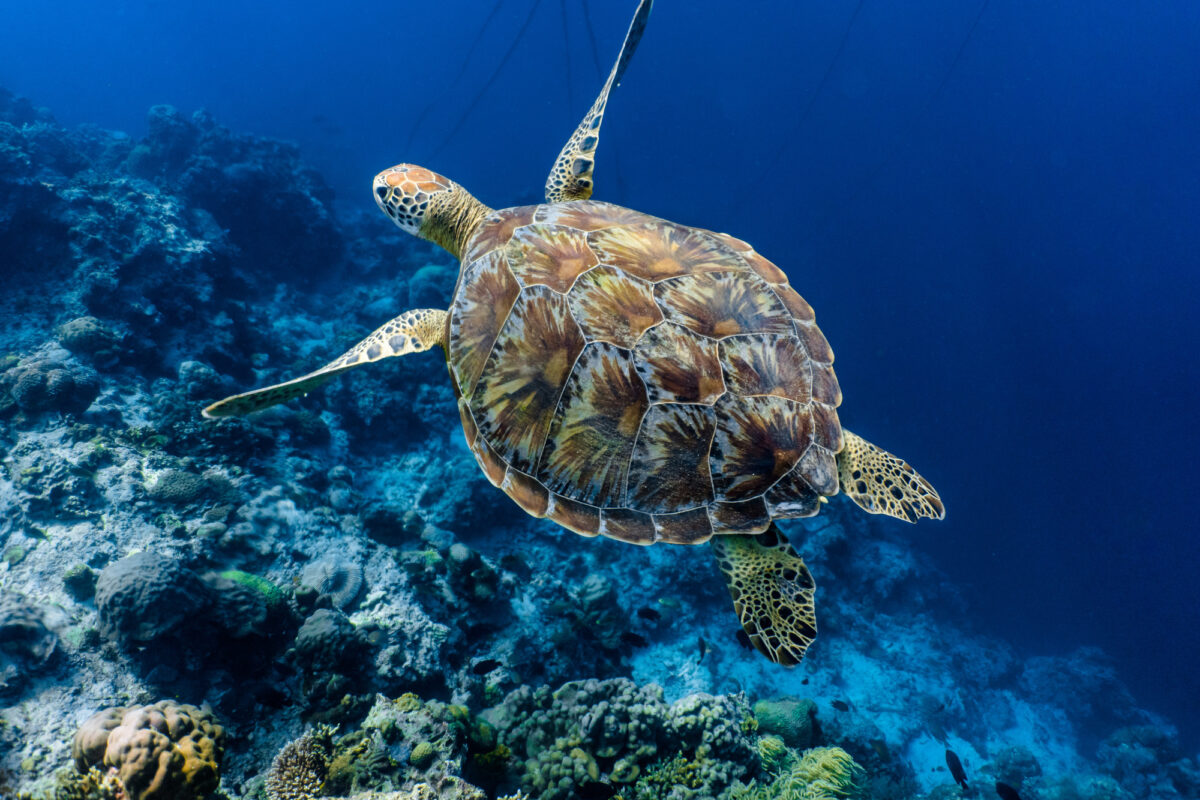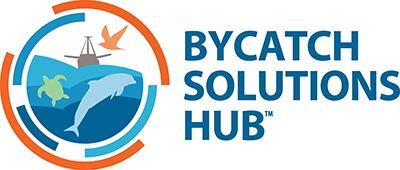Bycatch species
Sea Turtles
There are seven species of sea turtles in our oceans, most of which are found in tropical and temperate waters.
Most sea turtles have a similar life-history, after hatching on beaches they move offshore and spend the majority of their juvenile life in pelagic waters before migrating back to coastal waters when nearing sexual maturity.
Because of this, sea turtles are susceptible to being caught in pelagic fisheries as juveniles and coastal fisheries as adults. This is especially problematic for coastal fisheries that operate near nesting beaches during the nesting season. While species are found globally, extinction risk of regional populations of sea turtles (e.g. Northeast Indian Ocean) can vary tremendously and are therefore need to be assessed independently (when possible). Many of these regional populations are considered threatened or endangered.
Risks for sea turtles

Sea turtle
In pelagic fisheries, sea turtles are at a high risk of being caught in longlines and entangled in gillnets and purse seine nets. This is particularly true for endangered leatherbacks that spend most of their life in the open ocean. Sea turtles are attracted to the baited hooks on longlines and can either get hooked or entangled in the branch line. Such injuries can be fatal, especially if the hook is swallowed. In addition, if they become hooked or entangled and can’t reach the surface, they will eventually drown.
In purse seine fisheries, sea turtles can be safely removed from the net while still in the water and with best handling methods mortality can be negligible. If entangled in gillnets or other set nets, sea turtles are likely to drown, though there are some mitigation methods that can decrease the likelihood of entanglement.
Coastal trawl and net fisheries present a high bycatch risk for sea turtles especially bottom fisheries that target groundfish, shrimps, and crabs. This risk is highest near nesting beaches, where mature females spend months in nearshore waters. While mitigation methods exist for these fisheries, temporary fishery closures during the nesting season are the only way to substantially decrease bycatch mortality.
Fishery Impacts
- Require the use of circle hooks.
- Require the use of fish as bait in place of squid.
- Provide best methods handling and release training to the captain and crew.
- Promote deeper sets or night sets in fisheries where it is safe and effective.
- Require 100% coverage on all fishing vessels, combination of human observer and electronic monitoring, with detailed bycatch data collection.
- Ensure 100% compliance with all management measures specific to sea turtles, both at the country and management organization level.
- Require the use of turtle excluder devices in fisheries that pose a risk to sea turtles.
- Provide best methods handling and release training to the captain and crew.
- Require 100% coverage on all fishing vessels, combination of human observer and electronic monitoring, with detailed bycatch data collection.
- Ensure 100% compliance with all management measures specific to sea turtles, both at the country and management organization level.
- Transition to alternative gear types effective for the fishery.
- Restrict fishing in regions and times of the year with high bycatch rates, especially where fishing occurs near nesting beaches.
- Set gillnets so the float line is ten meters below the surface.
- Require the use of net lights in areas with documented bycatch.
- Provide best methods handling and release training to the captain and crew.
- Set a tracking device on all gillnets, with initial emphasis on driftnets, so nets can be tracked and recovered if lost.
- Require 100% coverage on all fishing vessels, combination of human observer and electronic monitoring, with detailed bycatch data collection.
- Ensure 100% compliance with all management measures specific to sea turtles, both at the country and management organization level.
- Require the use of non-entangling and biodegradable FADs.
- Provide best methods handling and release training to the captain and crew.
- Require 100% coverage on all fishing vessels, combination of human observer and electronic monitoring.
- Ensure 100% compliance with all management measures specific to sea turtles, both at the country and management organization level.
In longline fisheries, sea turtles are attracted to baited hooks and can become hooked or entangled in the branch line. If hooked near the surface sea turtles are unlikely to drown, though the mortality rate is estimated to still be high due to serious injury from swallowing the hook or from wrapped line tightening around the body when hauling.
Sea turtles are most likely to be impacted by longline fisheries in tropical and subtropical fisheries, through there is still a risk for bycatch of loggerheads and leatherbacks in temperate waters. Sea turtles are also most likely to be caught in pelagic shallow-water fisheries that target tunas, mahi, marlin, swordfish and sharks. Therefore, these fisheries are priority for the implementation of sea turtle bycatch mitigation methods.
Night sets and deeper sets … lead to lower bycatch rates.
For longline fisheries, effective bycatch mitigation methods exist and are required in some regions. The use of fish as bait in place of squid decreases sea turtle interest in the baited hook, and the use of circle hooks substantially decreases their ability to get hooked. In addition, less elastic leader lines decrease entanglement rates and make disentanglement on the deck easer, quicker, and safer for both the crew and sea turtle. Night sets and deeper sets are also less likely to overlap with foraging sea turtles and therefore lead to lower bycatch rates. Through the use of a combination of these methods, pelagic longline fisheries have shown the ability to greatly reduce sea turtle bycatch rates.
General Recommendations:
Coastal trawl fisheries for demersal fishes and crustaceans (shrimp, prawns, crab) have historically led to large decreases in sea turtle nesting populations. Sea turtles feed and rest on the seafloor and can get caught in the trawl net and drown. Catching sea turtles (as well as other unwanted bycatch) can be effectively avoided through the use of turtle excluder devices in the trawl net. Laws that require their use in certain regions have led to very substantial decreases in sea turtle bycatch in trawl fisheries. However, their use is not global and there are many areas with well-developed trawl fisheries that overlap with endangered sea turtle populations that do not use these excluder devices.
Sea turtles feed and rest on the seafloor and can get caught in the trawl net and drown.
For many of these fisheries, no observer program exists and therefore their impact on sea turtles, or other ETP bycatch, is not well understood. The primary focus for regions that have coastal trawl fisheries that overlap with sea turtle populations needs to be to develop observer programs to better document and understand where bycatch risks are greatest.
General Recommendations
Sea turtles can swim into gillnets and become entangled and drown. The impacts of gillnets on sea turtles has increased over the last couple decades as the use of gillnets has increased. Gillnets are very effective at entangling anything that swims into them and few proven mitigation methods exist for any bycatch.
Gillnets are very effective at entangling anything that swims into them.
For gillnets, the best way to decrease bycatch risk is to restrict fishing in regions and seasons that sea turtle abundances are highest. However, the use of net lights has shown promise in early stage implementation and lowering the float line (top of the net) so it is a few meters below the surface also decreases the sea turtle bycatch rates.
General Recommendations
Purse seines present a much smaller threat to sea turtles than longlines, trawls, or gillnets. However, sea turtles do get encircled in the net, especially if set around a fish aggregating device (FAD). If encircled, proper care needs to be taken to release the sea turtle before becoming entangled in the net or hauled on deck. If hauled on deck proper handling and release training can greatly increase survival rates.
In addition, sea turtles can get entangled in FADs that utilize hanging nets and ropes to attract more fish. This can be avoided through the use of non-entangling FADs. It is important to require documentation of all encounters and proper handling and release training to the captain and crews.
